|
|
Sole Criterion: Brand Upon the Brain!By Brett Ballard-BeachSeptember 6, 2012
Maddin strikes me as an artist wholly unto himself, as much a self-taught film geek as a Tarantino but one with completely apposite references and an affinity for earlier film eras (and with a very important caveat: a consistent partnership with George Toles, a film professor and mentor-turned-collaborator who has written or co-written with Maddin the stories and/or screenplays on the lion’s share of Maddin’s feature-length efforts.) In his recurring predilections paired with his faithful recreations/homages of silent film era cinematic vernacular, he calls to mind aspects of the nurtured obsessions of Bunuel, the unleashed unconscious of Lynch, and the carefully (almost suffocatingly) realized genre exercises of Todd Haynes. These are reference points, however, not borrowed or stolen ideas. Maddin is unlike any filmmaker I have encountered before. In the interviews with him on the DVDs (or in Waiting for Twilight, an hour-long documentary/promotional piece from 1997 that almost overkills on hipster-courting self-congratulation thanks to narration by Tom Waits), Maddin seems pleasant, down to earth, even a little bland, well read with an unquenchable scholarly, literary and celluloid thirst, and an artistic bent that he uses to sketch out color storyboards of his projects. Making movies is his everything, but in person he comports with none of the rapid-fire patois of Tarantino or Scorsese. Repression and isolation (both of which come into play from his Great White North background) and the bubbling over that can result from that is at the heart of a lot of his films. Amnesia is shared by most of the major characters in Archangel (1990) The mountain villagers who must speak softly (or risk triggering avalanches) in Careful instead transfer their energies into barely concealed Oedipal conflicts and would-be incestuous relationships. The broken family unit at the center of The Saddest Music in the World contains both an amnesiac, sibling rivalry and father/son competition for the same woman.
|

|
|
|

|
Friday, November 1, 2024
© 2024 Box Office Prophets, a division of One Of Us, Inc.


